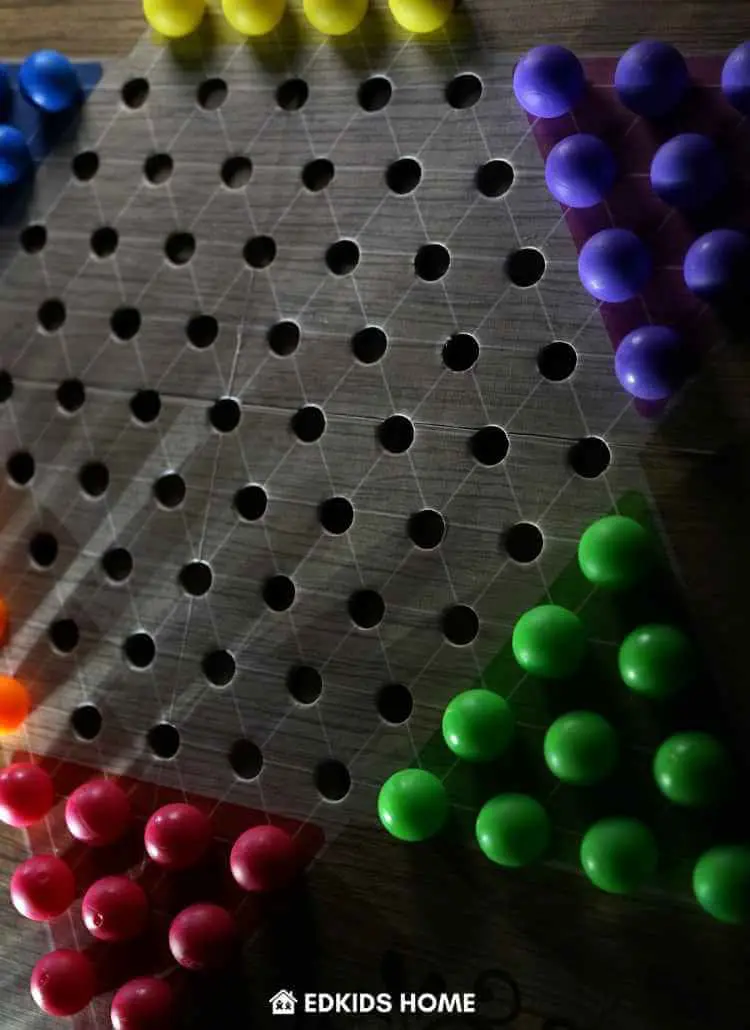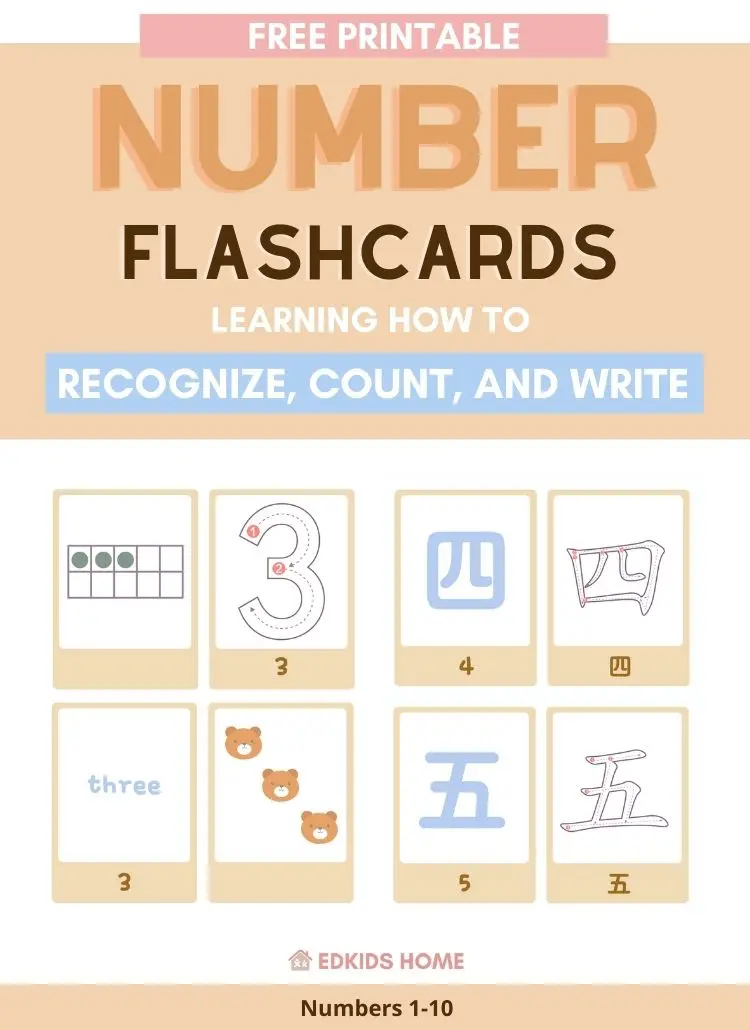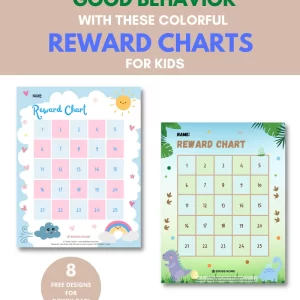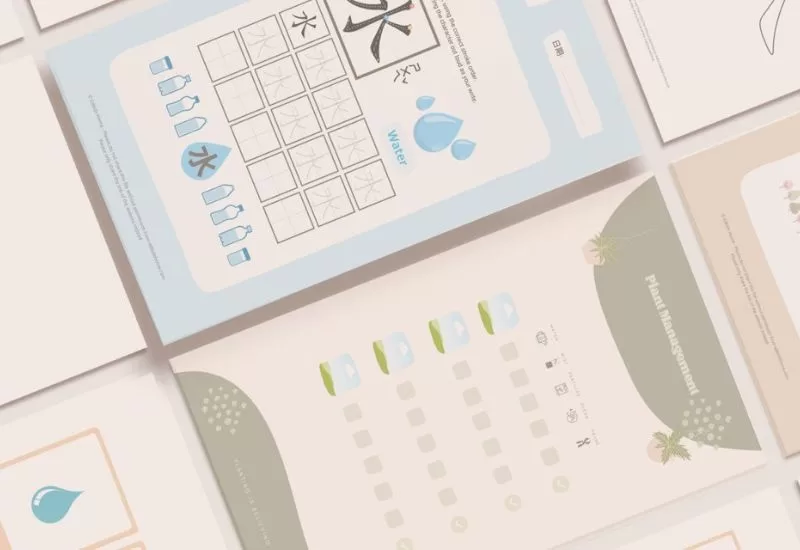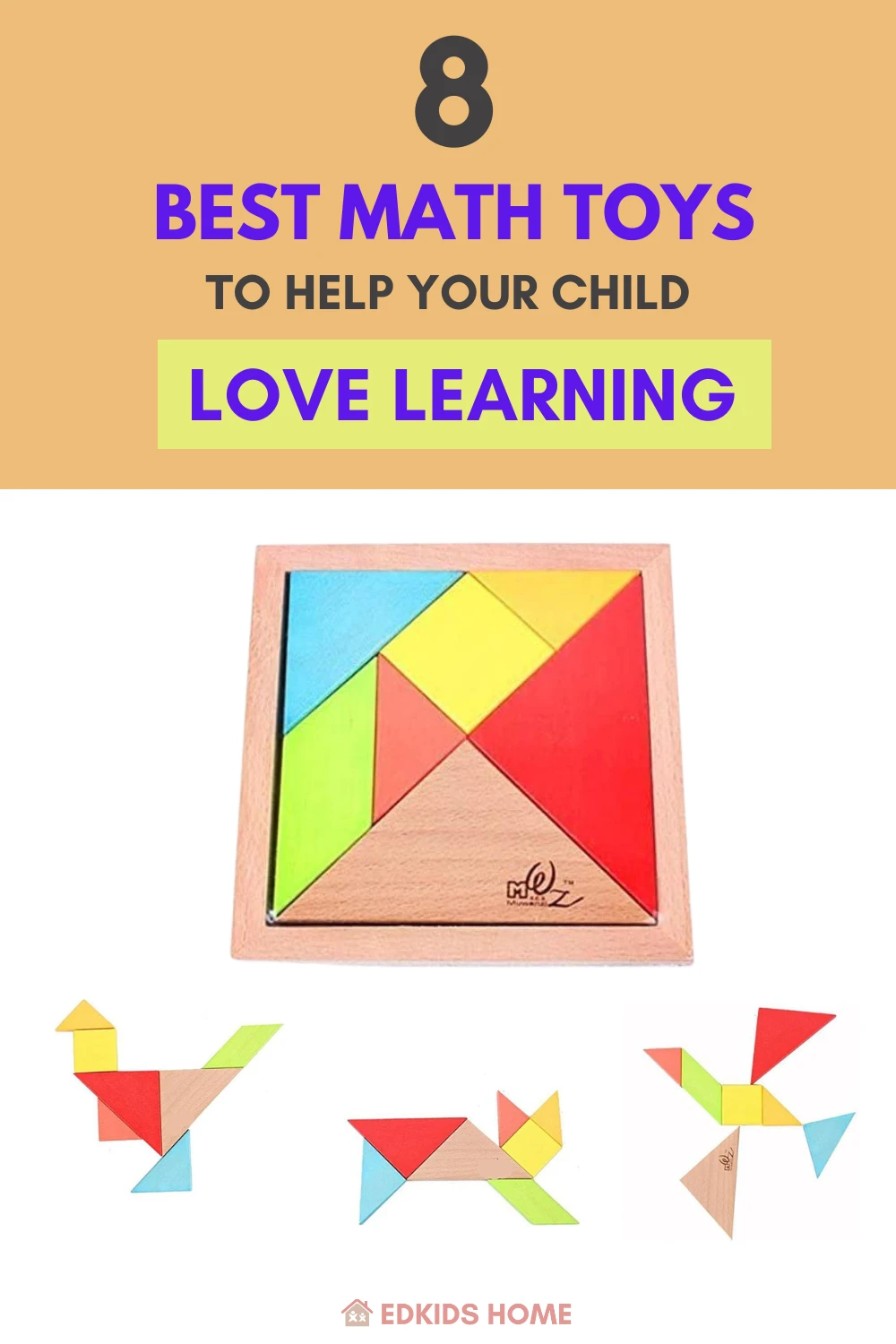
If your child struggles with math, you may be looking for ways to help them overcome their anxiety. One way to do this is by using math toys. These toys can help make learning math fun and engaging, which can reduce feelings of anxiety and stress.
During my childhood, I remember seeing many of my classmates hate math. The main reason is that they were lost and struggling to understand a concept. Eventually, it got more problematic as the lesson went on.
Children need to love learning and be curious about it to learn effectively. Stuffing them with worksheets will not make them enjoy math.
I started giving my 6-year-old daughter more worksheets to supplement her homework, but one day she got fed up and said they were uninteresting. I stopped for a while because I had to rethink my strategy.
This is where the math toys came into play. I began using them to supplement worksheets and noticed an impressive change in my daughter's understanding and excelling ability of concepts previously tricky for her to grasp.
This blog post will discuss 8 of the best math toys available today, and we will also share some additional printables and ways your child can use these math toys.
Math Anxiety: A Threat to Academic Success
MA has been repeatedly demonstrated to be associated with poor performance in mathematics.
Foley et al., 2017
For many children, math can be a daunting task. Math anxiety (MA) is a real problem that can impact children's performance in the classroom and beyond.
MA has been repeatedly demonstrated to be associated with poor performance in mathematics (for a recent review, see Foley et al., 2017).
This is a problem that needs to be addressed, as math anxiety can have a severe negative impact on students' education.
Why Does Math Anxiety Happen?
There are many reasons why math anxiety may develop. One of the most common reasons is math difficulty. Children who have difficulty understanding math concepts feel anxious and ashamed about their lack of ability.
This can lead to a vicious cycle, as math anxiety can make it harder for children to understand math concepts. This can then lead to increase math anxiety, and so on.
Other factors contributing to math anxiety include fear of failure, low self-esteem, negative past experiences with math, and pressure from parents or teachers. If you think your child may be struggling with math anxiety, it's essential to address the problem as soon as possible.
There are many ways to help children overcome math anxiety. They can overcome it with proper support and perform better in mathematics class.
Math toys can make learning math more fun and engaging, reducing children's anxiety levels.
One way to help is utilizing math toys. Math toys can make learning math more fun and engaging, reducing children's anxiety levels. In addition, math toys can also help students learn and understand mathematical concepts better.
8 Best Math Toys to Help Your Child Succeed in Math
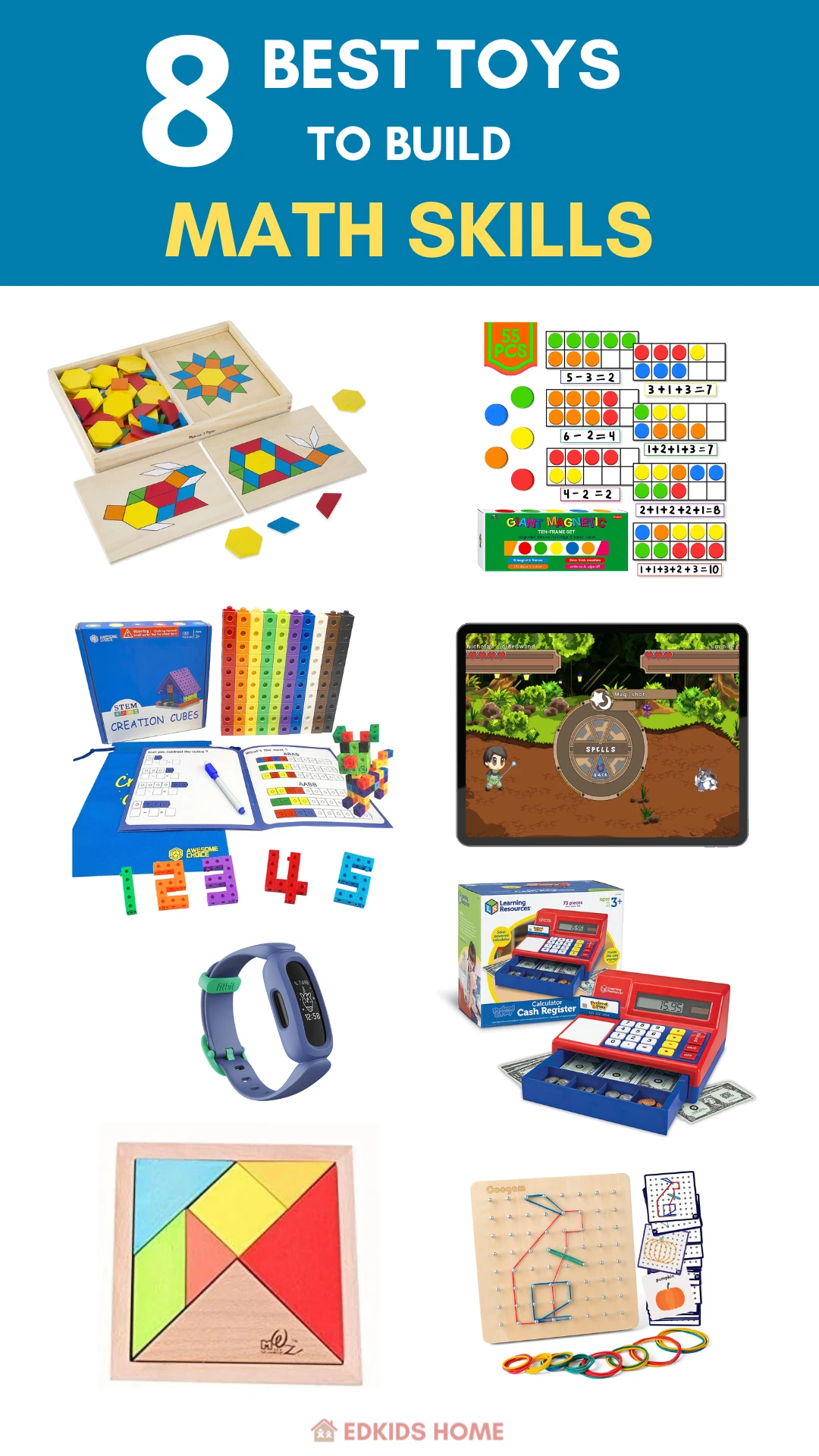
As any parent knows, getting kids to sit still and focus on anything can be challenging. However, when it comes to math, it can feel like an impossible task.
Luckily, there are math toys to help make learning math fun and engaging for kids. Math toys can come in simple games or more complex puzzles, but they all have one thing in common: They can make math more enjoyable for children.
In addition to being fun, math toys also help children to develop critical mathematical skills and concepts. As children play with math toys, they learn to identify patterns, count objects, and solve problems. In other words, math toys are a great way to help kids learn essential math skills in a fun and engaging way.
We also have different scores for each math toy. A low or high price means it is cheap or expensive compared to the other listed products. The product's popularity score reflects how often readers click on and buy it. The quality score assesses the overall performance and satisfaction with the product compared to others in its category.
Here are 8 of the best math toys to help your child succeed in math:
1. Pretend & Play Calculator Cash Register
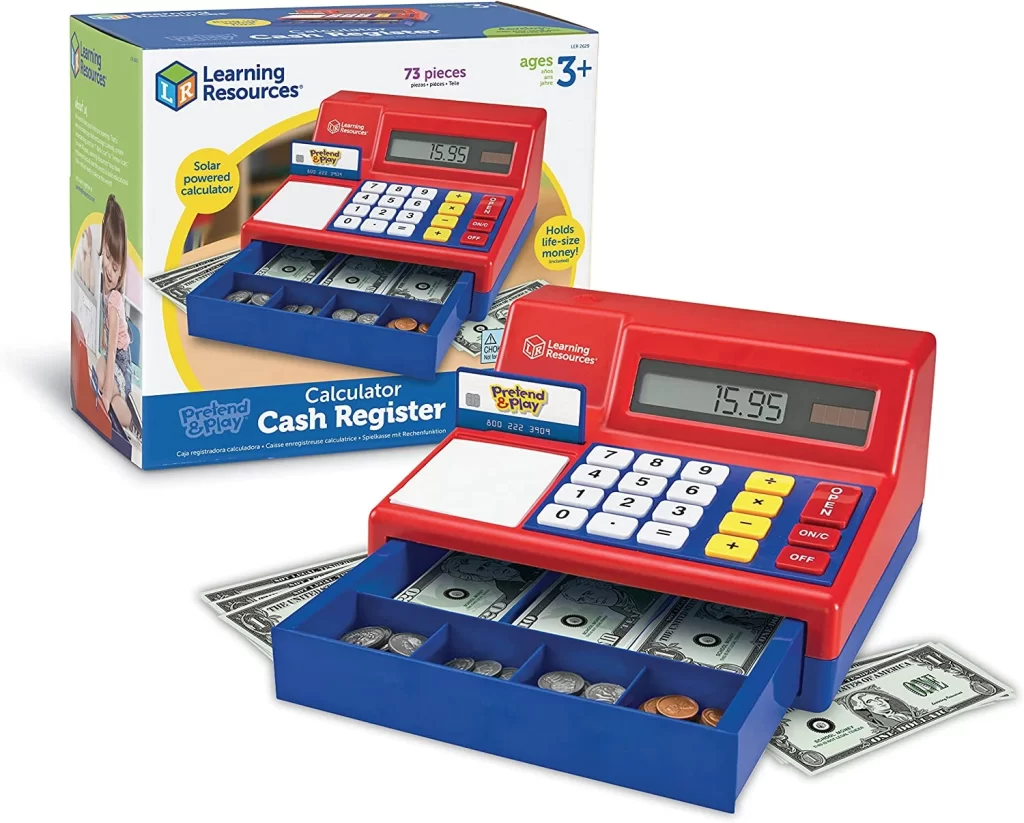
Skill Development:
- Math
- Pretend play
- Real-sized & realistic paper money & coins
- Authentic cash register noises
- Available in both Canadian and American money
- Solar-powered
- Functional display screen
- Calculator function
- Large buttons
Recommended Age: This is an excellent math toy for kids 3 and up, but with some parental guidance, it can be enjoyed by kids as young as 2.
Price: $$$$
Quality: 4/5
Popularity: 5/5
What We Love:
- Real-sized & realistic paper money & coins
- Authentic cash register noises
- Available in both Canadian and American money
- Solar-powered
- Functional display screen
- Calculator function
- Large buttons
Drawbacks:
- Paper money is not laminated
- Few slots in the drawer
Math Toy Review:
With this 73-piece set, your child will get real-sized fake paper money, plastic coins, a fake credit card, and an activity guide. This register comes with two money options- Canadian or American currency.
This cash register makes a ringing sound like a real one. Furthermore, it also has a working screen and realistic buttons that appear on the screen when pushed.
Children can learn currency denominations and have fun handling life-size money with this self-help tool. The cash register can assist students with money management skills when purchasing. Another great perk of this toy is that it's solar-powered, so you won't need to continuously replace batteries.
This toy makes learning to recognize and count money easy and fun. Children will learn how to give you the correct change as they play. Since it's so much fun, this would be a great activity for several children.
Some reviewers thought the non-laminated paper money was bad because little kids are usually rough and may easily tear the paper money. Also, even though there are 4 different types of paper money in the kit (20's, 10's, 5's, and 1's), the register only has three slots to store the paper money and four slots to store coins.
Our Experience:
My 5-year-old daughter and I love playing with this toy, which simulates a real-life grocery store. We write down prices for her toys and take turns being the cashier and customer. This math toy is great fun for us. Additionally, it helps her learn essential skills like math and budgeting with money. Which will lead her when she is old enough to shop for groceries or other items independently. to shop for groceries or other items independently.
My two-year-old son is also allowed to play with this. While I introduce coins such as toonies and loonies, I also provide a piggy bank so he can practice some fine motor skills.
Here are some worksheets you can use this math toy as a supplement:
- Money – EduBuzz Kids (US)
- Canadian Money Worksheets – Homeschoolmath.net
- Canadian Money Worksheets – Math Worksheets 4 kids
2. Pattern Blocks and Boards Math Toy
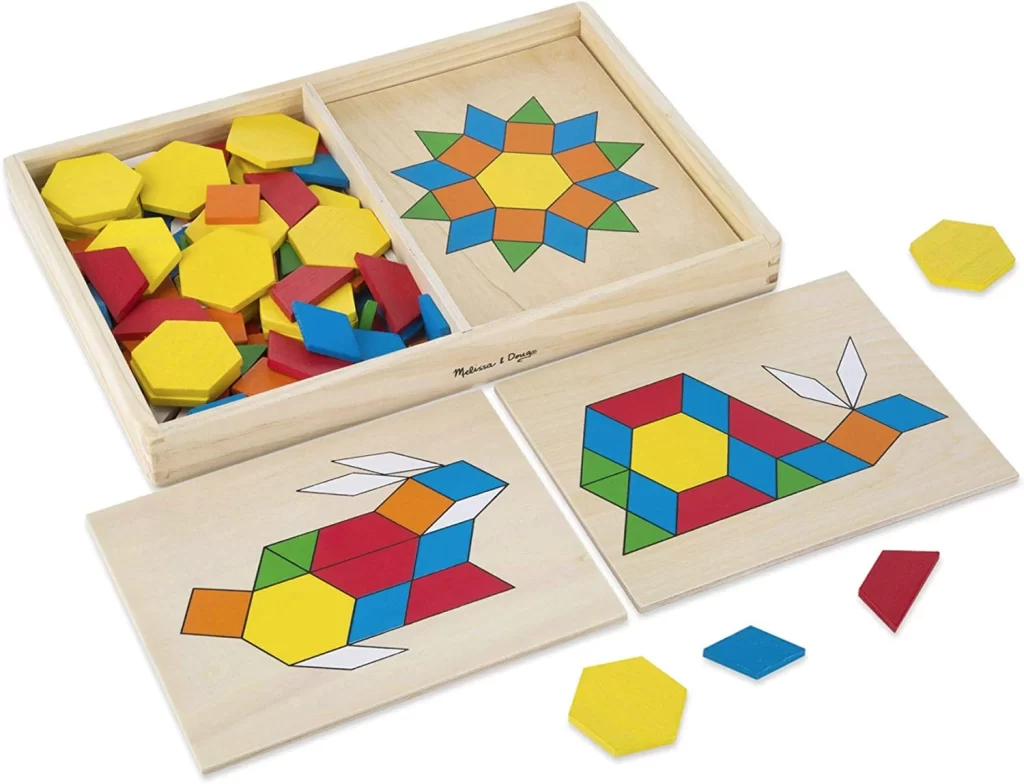
Skill Development:
- Spatial awareness
- Shape & color recognition
- Hand-eye coordination
- Problem-solving
- Creativity
- Math & STEAM
Recommended Age: 3+ years old
Price: $$$
Quality: 4/5
Popularity: 4/5
What We Love:
- Double-sided boards with ten design templates
- Good quality wooden pieces
- Sturdy wooden board & box
- Countless ways to play
- Great for quiet time
- Lots of skill developments, including dexterity, hand and eye coordination, and more
Drawbacks:
- Slippery
Math Toy Review:
This set of 120 wooden cubes is perfect for exploring math and geometry concepts. Kids can learn to count and make patterns with colorful pieces. They can also group the pieces by shape or color. The possibilities are endless!
With this set, you'll receive six shapes: a hexagon, trapezoid, square, triangle, parallelogram, and rhombus. You can get creative with all the ways these can create patterns. This also comes with 10 design templates on five wooden boards.
The pieces in this set come with a designated wooden box for the organization, along with five bonus templates. Additionally, since the lid of the box opens and closes, it allows children to practice their fine motor skills.
If you're looking for a way to pass the time, why not try playing with patterned blocks? With these blocks, you can create backward and forward patterns. They're perfect for quiet playtime at home or when you're out and about waiting for an appointment. Adults and children alike will enjoy their pattern-making magic.
Some users may complain that the pieces are pretty slippery when you try to match the shapes on the boards. But this can be an opportunity to enhance your child's fine motor skills.
Our Experience:
The 3-year-old I introduced this math toy to loves the train and boat template best, but my daughter's favorites are flowers and butterflies. The nice thing about the templates is that they suit both boys and girls.
My daughter continues to play with this set by using some of the more challenging tangram puzzles I've found online. Additionally, she enjoys using the pieces to create elegant patterns and pictures.
Here are some free printables you can print to supplement this math toy:
3. Wooden Tangrams Math Toy
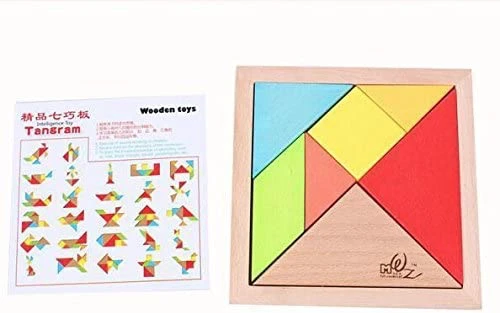
Skill Development:
- Patterning
- Spatial reasoning
- Problem-solving
- Geometry
- STEAM
- Fine motor skills
- Color learning
Recommended Age: 4+
Price: $
Quality: 4/5
Popularity: 1/5
What We Love:
- Durable
- Imaginative play
- A powerful tool to tackle math anxiety
- Builds teamwork and cooperation
Drawbacks:
- Some pieces are small and could be easily lost.
Math toy review:
With this 7-PCS Tangram Puzzle made from wood and non-toxic paint, your child can have fun while developing patience, creativity, and focus. The different colors in each block attract kids' attention. They will love learning the shapes such as squares, parallelograms, and triangles with this set.
Not only are tangrams great for fostering spatial awareness and reasoning skills, but they're also excellent tools for teaching foundational math skills in the classroom. This is because children often feel less anxious when working with tangrams, as opposed to numbers alone.
Tangrams not only improve your strategic thinking, but they are also fun! By playing with tangrams regularly, kids will learn how to build other figures and establish relationships between different shapes. In addition, tangrams allow children to explore geometry by deconstructing shapes into smaller parts and then reconstructing them into new forms.
Our experience:
One of our relatives' friend, a retired teacher, gave my 6-year-old daughter a tangram puzzle. In the beginning, I was lost and didn't know what to do with these puzzles. So I googled and realized this originated in China and that puzzles greatly boost math learning.
I started printing a few free tangram puzzle printables and introduced them along with the puzzles to my daughter. We were all hooked. Initially, she could not do the puzzles herself, so I stepped in, and we both worked together. It was a good family bonding time because her dad occasionally joined in.
There are a lot of free printables for the tangram puzzles, so I started printing them off and put them in a binder with plastic sheet protectors.
Here are some of the tangram puzzles you can use:
- Tangrams: 330 Puzzles Paperback
- Tangrams: 550 Puzzles Paperback
- Printable Tangrams Animal Puzzles – Woo! Jr
- Tangrams – Clip Art Etc
4. Mathlinks Cubes Toy
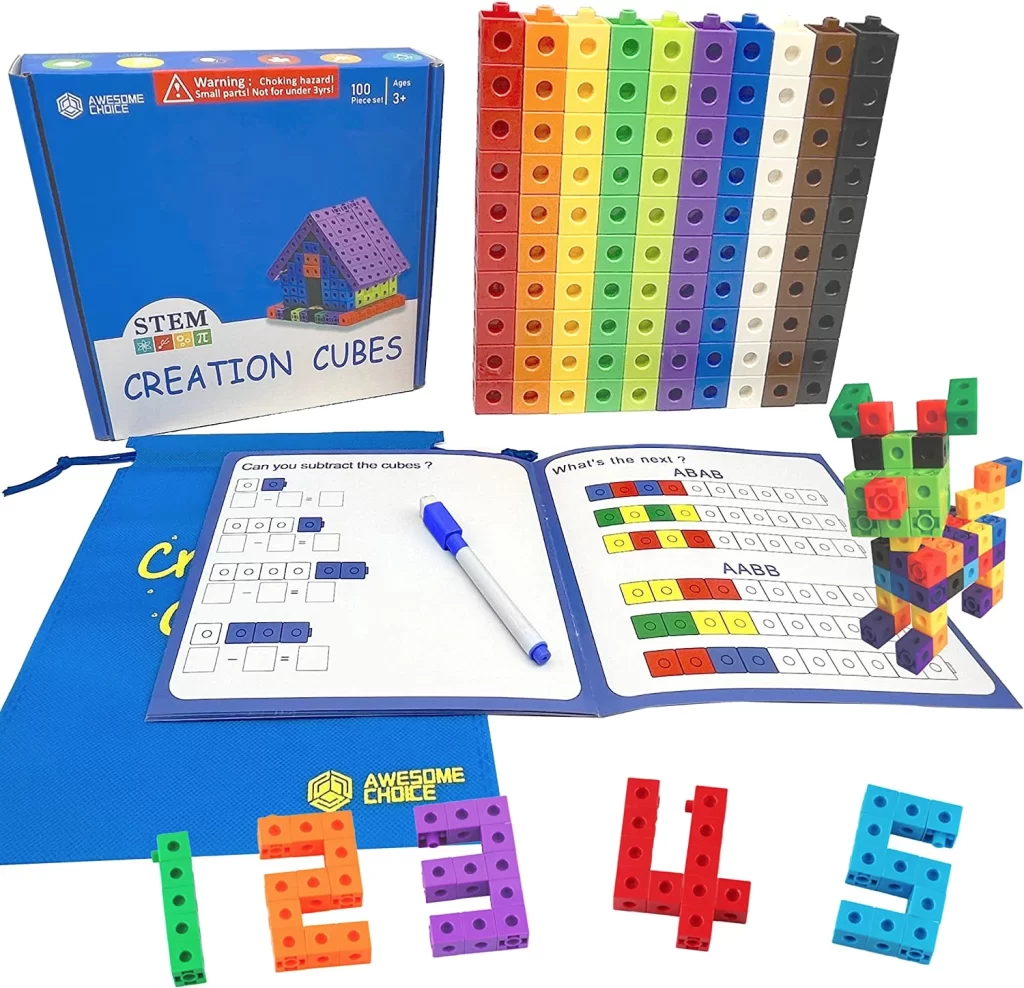
Skill Development:
- Counting and math
- Spatial reasoning
- Motor skills
- Creative thinking
- Sorting and patterning
- STEAM
- Fine motor skills
- Hand-Eye coordination
Recommended Age: 4+ years old
Price: $
Quality: 4/5
Popularity: 4/5
What We Love:
- They can snap together and build endless things
- Bright different colors
- Suitable for fine motor skills
- It comes with an activity book guide
Drawbacks:
- Easy to lose pieces
Math Toy Review:
These math cubes are an excellent way for kids to learn about math. They can use them to count, see patterns, and sort. The cubes also come in different colors, so kids can learn about colors too. The cubes are easy for small hands to grip and connect together. Kids can also use them to build towers!
With this 115-piece cube set, you'll have more than enough colorful cubes to visualize the 100's math table effectively. The best part is that these cubes snap together quickly so that you can rearrange them in any order or combination of colors.
Your child will learn addition, subtraction, multiplication, division, sequencing, and grouping with this set. The included large cards are easy to read and guide your child through learning math theories. With so many possibilities for learning, your child will be engaged for hours on end.
Your child will love building with these cubes, which can stack on top of each other or fit together sideways. With these educational blocks, they can create masterpieces.
Reviewers liked that even though they are easy to assemble and disassemble, once put together, the cube is sturdy and won't fall apart easily. These cubes snap on and off easily. Even little hands can do it themselves.
Lastly, I love how it includes a math activity book which makes homework fun!
Our Experience:
When my daughter was 3 years old, she loved Number Blocks. We would build the number of block characters while watching the show. She learned a lot about numbers through the series.
When she turned 5, I used math cubes as a supplement to help her understand the place values of ones and tens.
Here are some resources you can check out to complement this math toy:
- Numberblocks – Youtube Channel
- Tens & Ones Practice – 123Homeschool4me
- Snap Cube Pattern for Preschoolers – Play to Learn Preschool
- Snap Cube Summer – Fun Early Learning
- Free Snap Cube Number Mats – Preschoolmom
5. Wooden Geoboard Mathematical Toy

Skill Development:
- Geometry
- Shape recognition
- Fine motor skills
- Angles
- Fractions
- Imaginative play
Recommended Age: 5+ years old
Price: $$
Quality: 4/5
Popularity: 4/5
What We Love:
- Sturdy and easy to use
- Great for exploring geometry concepts
- Enhances fine motor skills
- It comes with a lot of pattern cards
Drawbacks:
- The pegs are a little too big for small hands
Math Toy Review:
The package includes 1 wooden board with 64 nails that are only half-driven in, 35 pattern cards (5 of which are blank), and enough rubber bands to complete the project. The pegs are easy for small hands to grip and connect. Additionally, they will be able to build patterns. With this purchase, your child can learn about geometry while exploring shapes and angles.
The geoboard is an excellent way for kids to learn about geometry, shapes, angles, and fractions while also having fun. This math toy includes large cards with diagrams for kids to make with rubber bands. In addition, it can also help children who struggle with fine motor or visual motor skills as they build their own shapes out of the pegs.
These pegs are designed to be easily snap on and off, even for small children. Reviewers commented that not only is it simple to put together and take apart, but once it's assembled, the pegboard is very stable and won't collapse easily.
This makes it ideal for taking with you when you go out, whether going to a restaurant or visiting Grandma's house.
Our Experience:
My 5-year-old daughter enjoyed using this wooden geoboard to create shapes and patterns. With my help, she could identify the different shapes she was making. She also enjoyed taking the rubber bands out and putting them back in–a great way for her to work on his fine motor skills. Now that we've gotten more acquainted with geometry, I have started downloading worksheets for us to use together with this math toy.
Here are some resources you can check out to complement this math toy:
- Geo-boards free printables – Craft-Mummy
- 2D SHAPE ACTIVITIES FOR PRESCHOOL, PRE-K, AND KINDERGARTEN – Pocket of Preschool
6. Magnetic Ten Frame Math Toy Set
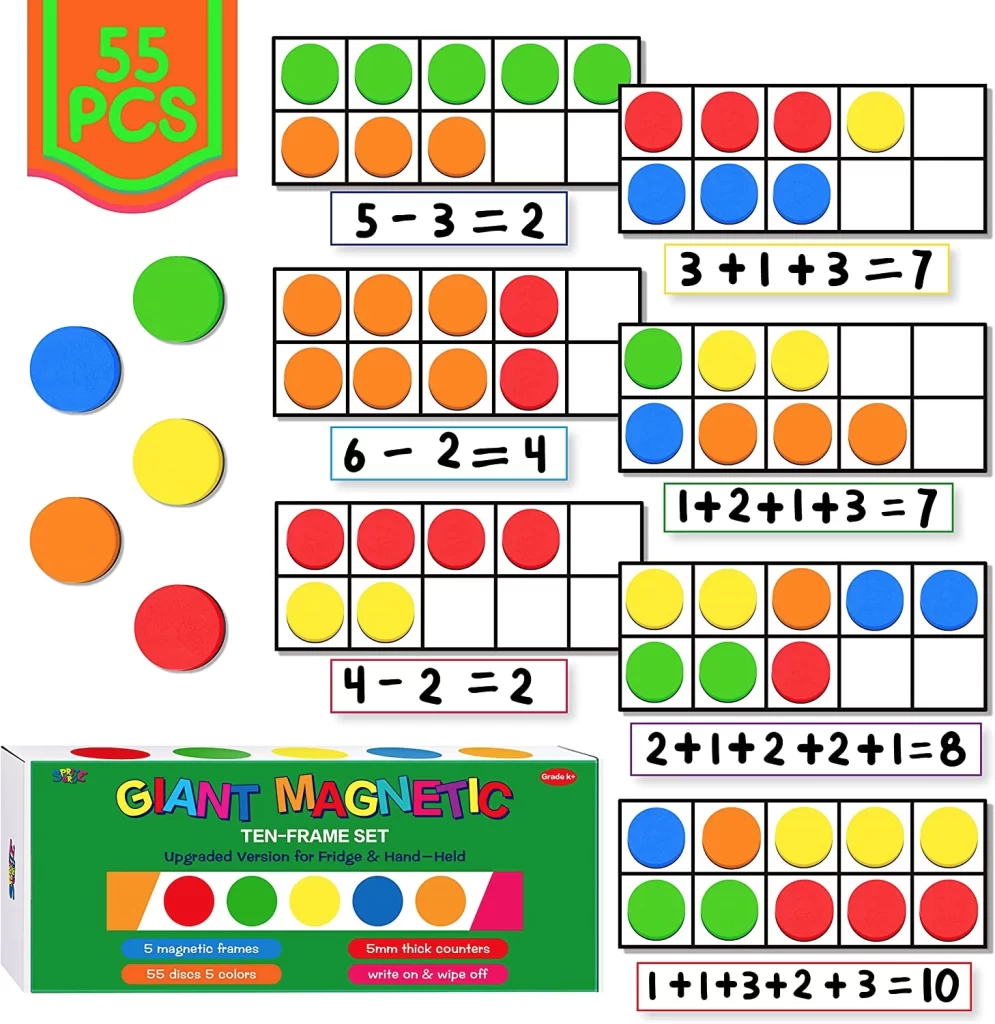
Skill Development:
- Number sense
- Operations
- Place value
- Addition
- Subtraction
Recommended Age: 3+ years old
Price: $$
Quality: 4/5
Popularity: 3/5
What We Love:
- A tool that helps with both visual and hands-on learning
- It can be stuck to a whiteboard so kids can solve problems.
- These magnets are thick and strong.
- Write-on & wipe-off frames
Drawbacks:
- The paint on the frame chips easily.
Math Toy Review:
This math toy is the perfect way to teach your child number sense, operations, and place value. The set includes 5 magnetic frames, 55 colorful discs (11 red, 11 yellow, 11 blue, 11 green, 11 orange), and an instruction guide.
This math manipulative is perfect for teaching and learning the foundational concept of 10. The colorful magnetic counters included in this set are easy for children to manipulate, allowing them to quickly recognize and understand number patterns.
By playing with these counters, kids will be able to master counting skills, practice addition and subtraction, and build a foundation for mental calculation skills – all while having fun!
Our Experience:
Children must establish a solid math foundation before moving on to more complex concepts. This way, the basics like addition and subtraction become second nature. And there are many ways to learn these simple operations.
It is beneficial for children to be exposed to multiple methods of learning math so they can visualize the concepts and think abstractly.
The magnetic 10 frameset is perfect for kids struggling to count, add, or subtract. The set includes a visual guide on sorting numbers into 5-10 frames so your child can easily understand and eventually master the concepts.
My 4-years-old daughter loved using this math toy to create numbers and solve problems. I was impressed with how quickly she picked up on the concepts. She was incredibly excited to use the whiteboard. We've been using this math toy for about a month now, and I can definitely see an improvement in her number sense and problem-solving skills.
I've also used this as a supplement for completing worksheets. Here are some free worksheets I recommend to complement this math toy:
- Addition with 10 Frames – Up to 20 Mathsheets
- Free Kindergarten Math Worksheets for Winter – Snowball 10 Frames
- FREE Printable Fruit Loops Preschool Ten Frame Math Activity
7. Prodigy Math App
Skill Development:
- Skill-building math questions
- Problem-solving
- Skill building
Recommended Age: 5+ years old
Price: Free (paid membership available)
Quality: n/a
Popularity: 4/5
What We Love:
- Many worlds to explore with new adventures
- Regular quests to earn rewards which increase motivation
- Provides curriculum progress and monthly reports
- Available for Grade 1-8
- Play with friends
- Adaptive algorithm to match your child's own pace and curriculum
Drawbacks:
- Can be addictive
- Excessive screen time
Math Toy Review:
Prodigy Math is an interactive and game-based educational app designed to make learning math fun for children of all ages. This multiplayer online game allows kids to explore different virtual worlds while engaging in magical combat with other players.
To cast their spells, kids must first solve math problems automatically calibrated to their skill level. Parents and teachers can easily support their learning as kids explore different worlds.
Children playing the Prodigy math games will be suited to adaptive challenges that fit their individual level. Within the game, they can gain rewards to stay motivated. Not only is this great for children, but it provides monthly reports on progress to parents! The best part? It's free for grades 1-8 and aligned with your curriculum!
Suppose you're willing to pay for a Prodigy math membership. In that case, you'll access additional features like in-game items and gear for your character, pets, and exclusive game areas.
Some people think that video games can be educational. But many parents are worried about the harmful effects of playing video games for too long. This includes problems with socialization and mental health.
Our Experience:
We discovered Prodigy Math from the school my 6-years-old daughter goes to. I am not a huge fan of screen time, but my daughter insisted on playing this, so we downloaded this app. Then, once she started playing, it reminded me of my childhood when I loved playing online multiplayer role-playing games such as Ragnarok.
I was amazed by how technology had progressed when I realized that my daughter could play games on her phone and answer mathematical questions. This is an extraordinary situation because she can have fun and learn simultaneously.
I only allow my daughter limited screen time because addiction is possible. Too much screen time could have adverse effects, which I try not to worry about as long as she isn't overusing them. Maintaining her excitement for learning is essential to me, and limiting her screen time will help with that overall.
8. Fitbit Ace 3 for Kids
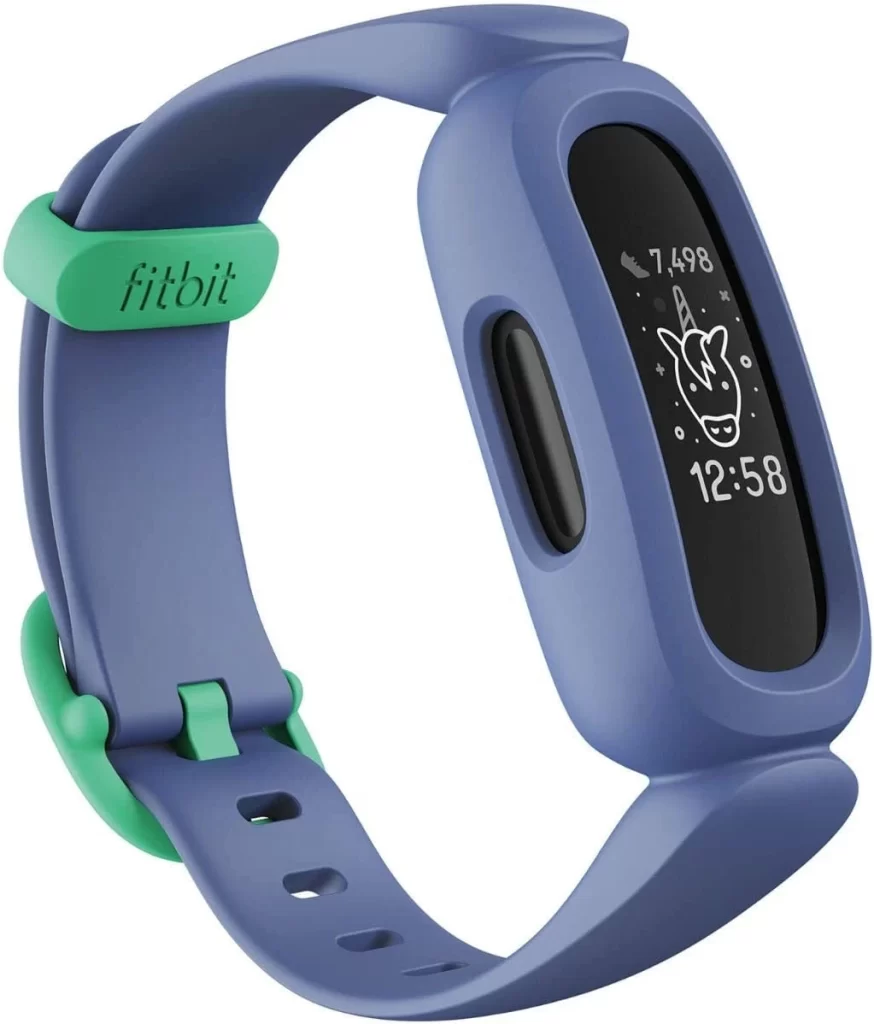
Skill Development:
- Counting
- Addition and Subtraction
- Problem-solving
- Time
Recommended Age: 6+ years old
Price: $$$$
Quality: 4.5/5
Popularity: 2/5
What We Love:
- Tracks activity and sleep
- Encourages kids to move more with games and challenges
- Family-friendly design and durability
- Waterproof
- Swappable bands as kids grow
- It can be worn 24/7
- It does not have games
Drawbacks:
- Have to recharge regularly
- no GPS for location tracking
Math Toy Review:
Fitbit Ace 3 for Kids is the perfect way to ensure your child gets enough activity during the day. This activity tracker encourages kids to move more with games and challenges and tracks their sleep at night. The family-friendly design is durable and waterproof, so it can be worn 24/7. The Ace 3 is available in two colors and has an adjustable band that grows with your child. It also has a rechargeable battery that lasts up to five days on a single charge.
The Ace 3 uses sensors to track sleep, steps, exercise time, and active minutes. It can also detect other types of activity, such as jumping or sports. Unfortunately, there is no GPS tracking available.
The Kid-friendly view in the Fitbit app lets them see their progress and stats but not the rest of the family's fitness data. Although it could be more kid-focused, it works well and definitely acts as a motivator–this was especially true for our younger testers.
Some might think that the lack of games or other distractions on the Fitbit Ace 3 is alarming. But it's a good thing. After all, schools are already trying to limit distractions for students during class time.
The Ace 3's long battery life is a crucial selling point, as it doesn't stop tracking at bedtime. Not only does it track sleep, but you can also set up reminders to help establish a daily bedtime routine for your kids. Plus, there's an alarm to wake them up in the morning!
Our experience:
My husband and I use a Fitbit watch to monitor our steps and calories burned daily. We have active lifestyles, so we think Fitbit influences our health—especially when we can see our daily progress. Then I noticed a kid's version of Fitbit called Fitbit Ace 3, which is perfect for my daughter.
Finally, my daughter received the blue unicorn Fitbit Ace 3 watch on her 6th birthday. The grade 1 curriculum involves learning about time, which would be a perfect supplement to help her understand more about time. This watch can also improve her ability to track time well, especially during the morning rushes when she needs to eat breakfast and head out of the house.
This watch is excellent for tracking her daily steps, sleep, and active minutes. When Fitbit nudges her because she completes a milestone, she jumps for joy. She will often report to me how many steps she took during the day, which helps her learn how to read large numbers.
The biggest downside to this math toy is that it doesn't have GPS tracking, but I don't see it as a significant problem. It's okay for the goals of the toy, which are teaching kids about time and getting them moving.
This watch can help improve daily routines in many ways. For example, we can use it to show my daughter when she should do certain activities and mark them on a routine chart. She also frequently uses the timer function when brushing her teeth, setting it for two minutes.
I strongly advocate this math toy to other parents! It's easy for kids to use, motivating, and doesn't interfere with daily routines like some other toys or devices might.
Read: Free Morning and Evening Routine Charts Printable: English, Chinese, French
Sources
- Math anxiety, intelligence, and performance in mathematics: Insights from the German adaptation of the Abbreviated Math Anxiety Scale (AMAS-G), www.sciencedirect.com
Conclusion About 8 Math Toys
Here is a chart to summarize the eight recommended math toys for kids:
| Math Toy | Age Recommendation | Price | Quality | Popularity |
| 1. Pretend & Play Calculator Cash Register | 3+ Years Old | $$$$ | 4/5 | 5/5 |
| 2. Pattern Blocks and Boards Toy | 3+ Years Old | $$$ | 4/5 | 4/5 |
| 3. Wooden Tangrams | 4+ Years Old | $ | 3/5 | 1/5 |
| 4. Creation Mathlinks Cubes | 4+ Years Old | $ | 4/5 | 4/5 |
| 5. Wooden Geoboard Material | 5+ Years Old | $$ | 3/5 | 4/5 |
| 6. Magnetic Ten Frame Set | 3+ Years Old | $$ | 4.5/5 | 3/5 |
| 7. Prodigy Math App | 5+ Years Old | Free | 3.5/5 | 4/5 |
| 8. Fitbit Ace 3 for Kids | 6+ Years Old | $$$$ | 4/5 | 2/5 |
There are many different ways that parents can help their children overcome math anxiety. One way is using math toys to expose kids to multiple methods of learning math. The Magnetic 10-frame set is perfect for kids struggling to count, add, or subtract. Parents can also use fun math toys like the Fitbit Ace 3 for Kids to motivate their children and improve daily routines.
Another way to help overcome math anxiety is using apps that make learning math fun. There are many different math apps available that can help kids learn in a fun and interactive way. Some of our favorites include Prodigy Math.
Finally, praising your child's efforts and successes in math is essential. Showing your child that you are interested in their math learning will help them feel more confident and motivated.
By using a combination of these strategies, you can help your child overcome math anxiety and develop a love for learning math.
What are some math toys you would recommend? Please comment and share below!

